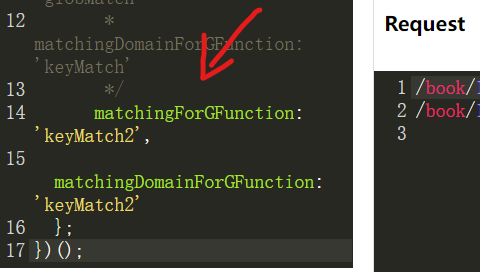RBAC with Pattern
Quick Start
use pattern in
g(_,_)e, _ := NewEnforcer("./example.conf", "./example.csv")
e.AddNamedMatchingFunc("g","KeyMatch2",util.KeyMatch2)use pattern with domain
e.AddNamedDomainMatchingFunc("g","KeyMatch2",util.KeyMatch2)use all pattern
just combined use of two APIs
As shown above, after you create the enforcer instance, you need to activate pattern matching via AddNamedMatchingFunc and AddNamedDomainMatchingFunc API, which determine how the pattern matches.
If you use the online editor, it specifies the pattern matching function in the lower left corner. 
Use pattern matching in RBAC
Sometimes, you want some subjects, object or domains/tenants with the specific pattern to be automatically granted to a role. Pattern matching functions in RBAC can help you do that. A pattern matching function shares the same parameters and return value as the previous matcher function.
The pattern matching function supports each parameter of g.
We know that normally RBAC is expressed as g(r.sub, p.sub) in matcher. Then we will use policy like:
p, alice, book_group, read
g, /book/1, book_group
g, /book/2, book_group
So alice can read all books including book 1 and book 2. But there can be thousands of books and it's very tedious to add each book to the book role (or group) with one g policy rule.
But with pattern matching functions, you can write the policy with only one line:
g, /book/:id, book_group
Casbin will automatically match /book/1 and /book/2 into pattern /book/:id for you. You only need to register the function with the enforcer like:
- Go
- Node.js
e.AddNamedMatchingFunc("g","KeyMatch2",util.KeyMatch2)
await e.addNamedMatchingFunc('g', Util.keyMatch2Func);
When Using a pattern matching function in domains/tenants, You need to register the function to enforcer and model.
- Go
- Node.js
e.AddNamedDomainMatchingFunc("g","KeyMatch2",util.KeyMatch2)
await e.addNamedDomainMatchingFunc('g', Util.keyMatch2Func);
If you don't understand what g(r.sub, p.sub, r.dom) means, please read rbac-with-domains. In short, g(r.sub, p.sub, r.dom) will check whether the user r.sub has a role p.sub in the domain r.dom. So this is how the matcher work. You can see the full example here.
Apart from the pattern matching syntax above, we can also use pure domain pattern.
For example, if we want sub to have access in different domains, domain1 and domain2, we can use the pure domain pattern:
p, admin, domain1, data1, read
p, admin, domain1, data1, write
p, admin, domain2, data2, read
p, admin, domain2, data2, write
g, alice, admin, *
g, bob, admin, domain2
In this example, we want alice to read and write data in domain1 and domain2, pattern matching * in g makes alice have the access to two domains.
By using pattern matching, especially in the scenarios which is more complicated and there are a lot of domains or objects we need to take into consideration, we can implement the policy_definition more elegant and effective.